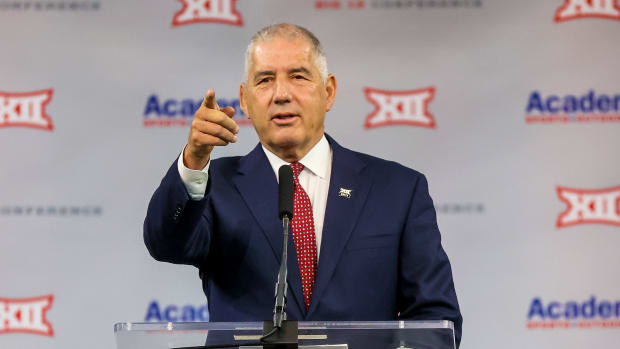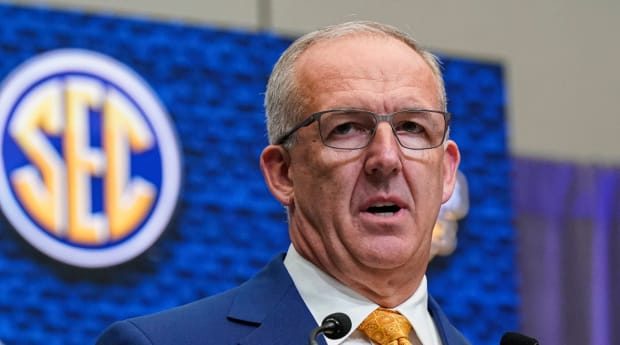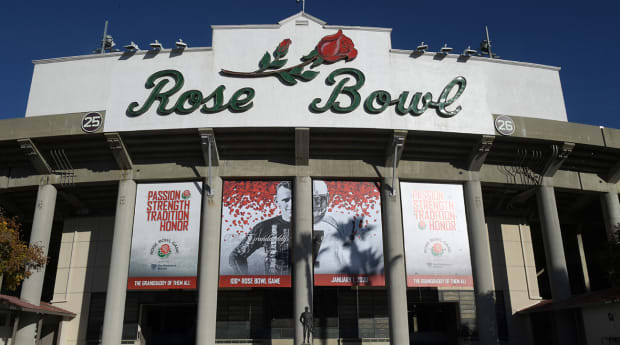DALLAS – Nothing is quick about college sports.
It’s not what you’d call a speedy industry. It does not walk—it crawls. In fact, college sports took so long to modernize its amateurism rules that politicians—politicians!—blew right past it.
And so, in no real surprise, college sports’ most powerful leaders last week adopted the same 12-team expansion model that was proposed in June 2021. Yes, it took 15 months. In fact, it took much longer.
In January 2019, the CFP Board of Managers, composed of presidents from the 10 FBS conferences and Notre Dame, tasked the conference commissioners to create and agree on an expanded playoff. Final tally: it took three years and eight months. Or, 1,333 days. Or 32,000 hours!
Now that expansion is agreed to, the real challenge begins: attempting to implement an expanded playoff before the current CFP contract ends. It runs through the 2025 playoff. While presidents agreed to expand starting in 2026, they are hoping commissioners can agree on the intricacies and cross the hurdles on expanding early. That means the same fractured group that couldn’t come to consensus during a year of negotiations will be back at the bargaining table.
Is it possible?
“It’s difficult but not insurmountable,” says the now-retired Bob Bowlsby, the former Big 12 commissioner who helped create the 12-team model and served as one of the most aggressive proponents to expansion.
“There are a lot of issues. Contractual components are significant with media partners and venues,” he continues. “Making hotel accommodations and availability for fans. There are 100 areas of details that must be dealt with.”
Many of those unresolved details were at the center of negotiations last fall, the same negotiations that ended in the Big Ten, ACC and Pac-12 resisting expansion for various reasons. They officially voted against the 12-team proposal in February. Because of the six-month delay, the CFP finds itself in a predicament—hurriedly having to agree on a number of unresolved issues to expand early.

Kevin Jairaj/USA TODAY Sports
The good thing is, everyone in the commissioner room is all on the same page! (Please note the sarcasm.) To that end, Bowlsby described the year of expansion discussions as “tortured.”
This doesn’t bode well for early expansion.
“We couldn’t make a decision in a year on the exact same format that was approved Friday,” SEC commissioner Greg Sankey says. “I expected us to collaborate to solve problems. That didn’t happen. We have more of a direction now but some of those same issues are in front of us.”
So what are those issues? Let’s get to it.
The calendar
When are the games played? At least a few commissioners contend that this is the single biggest question that must be resolved.
The playoff is doubling in size in terms of the number of rounds (two to four) and is nearly quadrupling in size in terms of the number of games (three to 11). That’s a significant swelling during a very tight window of the calendar, from mid-December to mid-January. There are hurdles to work around, like (1) the academic calendar (exams and the start of the second semester); (2) NFL regular season and playoff games (avoid competing with the NFL at all cost); (3) conference championship games (they normally are played the first weekend of December).
Commissioners have established tentative dates for the four rounds, but nothing is concrete. The first round falls roughly two weeks after conference title games. The second round kicks off on the typical New Year’s Eve and New Year’s Day window. The semifinals would be played a week later followed by a championship game that, depending on the year, could kick off two or three weeks into January.
The CFP tipped its hand in the release announcing the particulars of the new expansion: There must be at least 12 days between conference championship games and the first round. The 12th day after Saturday conference title games is a … Thursday.
“We all have to get ready for weekday playoff games,” says one high-placed source within the CFP.
To avoid competing against NFL regular season games—the league plays some Saturday games starting in mid-December—first-round college playoff games could find their way on a Thursday night. The NFL adopted its own playoff expansion two years ago, further complicating matters. For example, the league has scheduled at least one wild-card game on a Monday night in mid-January, a date that might normally be reserved for the college title game in an expanded field.
“It’s complicated,” says one administrator.
In an effort to alleviate the crammed window, one officials suggests turning Week Zero into Week 1, which moves the entire calendar up a week. But that creates issues, too. Rivalry week would move off of Thanksgiving weekend. Instead, Thanksgiving week would feature conference title games.
Watch college football with fuboTV. Start free trial today.
Revenue distribution
For some, this is the top issue to solve. Currently, the CFP distributes about 80% of its annual $600 million of revenue to the Power 5 leagues and roughly 20% to the Group of 5. A conference gets a $6 million bonus payment for every qualifying semifinal team and $4 million for each team playing in a non-playoff CFP bowl (the four bowls out of the Fiesta, Cotton, Orange, Sugar, Peach and Rose that aren’t in the semifinal rotation that year).
At the center of negotiations is specifically the 80% cut going to the Power 5. In light of realignment and the composition change to leagues, the Power 5 revenue distribution is in for some adjustment, many believe. Why?
“You now have the Power 2,” says one source familiar with CFP talks.
The Big Ten and SEC have not only dominated the event, but the conferences have swelled to 16 teams (or at least they will by the time 2026 rolls around). Why should the 10-team Pac-12 or 14-team ACC get the same cut as bigger conferences? Especially if those bigger conferences are responsible for the majority of CFP qualifiers. The SEC and Big Ten have qualified 16 teams for the CFP. The other three leagues have qualified 14.
You hear plenty of talk now about leagues like the ACC and Big Ten moving to a conference-wide uneven revenue distribution model (giving more bucks to the more valued and successful programs). Well, on the national scale, the CFP is almost certain to do the same with its new revenue distribution, including a bigger cut for the bigger leagues and those leagues that have most success in the field.
“It needs to be updated comprehensively,” says Sankey.

Dale Zanine/USA TODAY Sports
Media rights
The CFP is in the midst of a 12-year contract with ESPN that runs through the 2025 playoff. As mentioned above, there is a desire for an expanded postseason to start in 2024 or ’25.
However, ESPN has exclusive rights to the 2024 and 2025 playoffs by virtue of the contract. This is problematic for commissioners who want multiple networks to control playoff rights. Big Ten commissioner Kevin Warren and Pac-12 commissioner George Kliavkoff have been the most public about those wishes. In an unrelated—or maybe related—note, Warren’s league recently agreed to a new media rights package that does not include ESPN. Fox is the primary rights holder for the conference.
There are solutions to this media rights issue, but they all involve ESPN’s willingness to compromise. Will they? Late last fall, CFP sources told SI that the network expressed flexibility on this issue. However, plenty has changed since. There’s been another wave of realignment, the Big Ten signed its new ESPN-less deal and two Power 5 leagues (the Pac-12 and Big 12) have opened negotiations with the network and Fox on reaching a new media rights package.
If ESPN is willing, the network could nix the contract after the 2023 playoff in favor of a new, more long-term deal that would allow the inclusion of other media partners. Why would ESPN do this? The CFP could compromise with the network in negotiations. Maybe they get thrown a bone in some way.
Some believe this is all a non-starter and that ESPN will not budge on its exclusivity to the final two years of the contract. “No way,” says one CFP source. In that case, if they do expand early, commissioners would have to swallow a fact: ESPN will televise the entirety of 2024 and 2025 playoff before the expanded model then goes to market for bid.
However, going to market does not mean that the CFP will include multiple media partners starting in 2026, says Sankey.
“We all said for [2026], we would fully go to market with the media rights. What that conveyed is that everybody will have an opportunity to participate,” he said. “We were always going to market. There’s no guarantee we’d go with multiple media partners. That’s a possibility, but we have to see the actual proposals.”
The playoff sites
Commissioners aren’t the only ones carrying the burden of expanding early. Bill Hancock, the CFP executive director, and his staff are responsible for some of the most important issues.
“I’m sure this has given Bill a significant headache, but he’ll do everything he can to make it a reality,” Bowlsby says.
For Hancock and Co., priority No. 1 is the 2024 and ‘25 championship sites adjusting to the new date, likely a week later than originally scheduled. Will Atlanta (’24) and Miami (’25) be flexible enough? The CFP only just announced those cities as host sites for the championship games in January 2025 and January 2026, respectively.
“I suspect the cities will help us however they can,” Hancock said.
However, CFP sources tell SI that Atlanta might not be able to accommodate the CFP title game if it’s pushed back a week later than scheduled. The city’s hotel and convention space is already occupied with another event.
“That’s a big issue,” says one commissioner.

Kirby Lee-USA TODAY Sports
The bowls
Many of those residing east of the Mississippi and south of the Mason-Dixon line want to hear no more about the Rose Bowl’s wishes as it relates to a football postseason. And yet, here we are.
As written last July in SI, the bowl game wishes to remain at its traditional date and time. Officials representing the historic game prefer it to kick off at 2 p.m. local time on Jan. 1. They also wish to control their own television rights, which seems like a long shot. Playoff officials want the television rights to be under one umbrella, controlled by the CFP.
But there are solutions to incorporating the Rose Bowl and having it kick off at its normal time. The game could be a permanent quarterfinal, for instance. Kliavkoff has thrown out the possibility that the Rose Bowl be in the same rotation for a semifinal. On semifinal years, the Rose could also host on its traditional date and time for the best Big Ten and Pac-12 teams that do not advance to the playoff. That is unlikely to happen unless other CFP-affiliated bowls are granted the same opportunity.
“If the Rose has a unique set-up, so too will the Sugar and Orange, etc.,” says one source.
But enough about the Rose. What about the other bowls? Not the CFP-affiliated bowls, but the other bowls: the Gator, Citrus, Music City, Alamo, Holiday, etc.
Bowl Season, the organization presiding over the bowl system, believes that first-round games should be played at bowl sites instead of on campus. This is not a popular opinion held by the vast majority of college football fans, but one CFP official suggested that the discussion point—on campus vs. bowl games for the first round—isn’t necessarily over.
Student-athlete revenue sharing
There are few things in college sports that seem more of a certainty than the aspect of sharing media rights revenue with athletes. It’s coming, if not from college leaders themselves then from Congress or the courts.
Some estimate that a 12-team college playoff could generate a price tag of $2 billion annually, roughly four times its current value. The call to split such revenue with the players playing in the games will only grow louder as time passes. Credit CFP officials for acknowledging this exists.
Asked about it last week, Hancock told reporters that CFP officials “were having significant conversations about some way to provide benefits for the players.”







